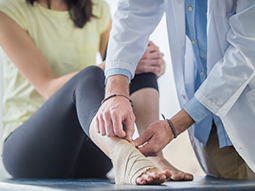Pediatric orthopedics is a subspecialty of orthopedics that focuses on the musculoskeletal problems common to children and adolescents. Children are not merely, as the saying goes, small adults — many basic differences exist between the orthopedic problems frequently seen in adults and those prevalent in children and adolescents.
The most unique characteristic of this age group is that they are actively growing; when physicians deal with pediatric musculoskeletal problems, they must consider the effect further growth will have on any treatments and on the anticipated outcomes.
In recognizing and emphasizing such differences, this subspecialty has opened the door to more careful study of both common and rare afflictions of the musculoskeletal system, which has led to upgraded treatment protocols and improved prognoses for many abnormalities.
The physicians at MedStar Health specialize in a wide range of diseases and abnormalities in children and adolescents, including:
- Routine pediatric orthopedic injuries and conditions
- In-toeing, also known as pigeon-toe
- Fractures
- Sports injuries
- Concussions
- Undiagnosed joint pain
Fractures
Fractures in children differ significantly from fractures in adults.
For instance, covering the surface of all bones is a membrane called the periosteum; a child's periosteum is thicker than an adult periosteum and contains active, bone-making cells with a very rich blood supply. Therefore, children's fractures heal much more rapidly than adult fractures.
Children rarely need physical therapy after their fractures heal — once a child's fracture heals and any cast is removed, normal use of the extremity is all that is required to restore function. Additionally, joint stiffness in children is quite uncommon, whereas in adults it is of much greater concern.
However, pitfalls also exist in children's fractures. At the end of each long bone (for example, the bones in arms or legs), children have a soft cartilage growth plate. This growth plate is sensitive to trauma or injury. On occasion, it can close or partially close, which means it can stop growing, leaving a child with a shortened bone or, more commonly, an angular deformity of the arm or leg.
With very severe or unusual injures — such as fractures around the elbow, adjacent to joints, or in or near growth plates — surgery may be necessary to realign the fractured pieces of bone.
Our providers

Expert orthopedic care
Getting the care you need starts with seeing one of our orthopedic specialists
Patient stories
Our locations
Distance from Change locationEnter your location
MedStar Franklin Square Medical Center
9000 Franklin Square Dr. Baltimore, MD 21237
MedStar Health: Orthopedics at Tenleytown
4200 Wisconsin Ave NW Fourth Floor Washington, DC 20016
202-444-7804









